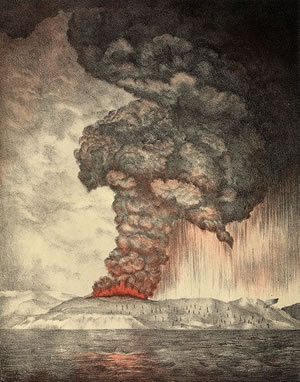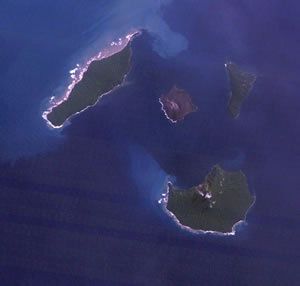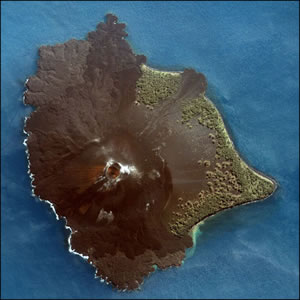The most violent volcanic eruption in recorded history took place on the island of Krakatoa on August 27, 1883.
At the beginning of that year, Krakatoa seemed an ordinary volcanic island, lying in the Sunda Strait between Java and Sumatra in what was then the Dutch East Indies and is today Indonesia.
Measuring 28sq.km (11sq.mi) in area, the island was dominated by a central peak 820m (2,700ft) high. Few islanders worried about the volcano - there had been no sign of activity since the mountain had erupted two centuries earlier, in 1681. Some even thought that the volcano was extinct.
 On May 20, 1883, the mountain's cone burst into life, hurling hot ash into the sky but dying down soon afterward. As the summer advanced, several other small eruptions followed.
On May 20, 1883, the mountain's cone burst into life, hurling hot ash into the sky but dying down soon afterward. As the summer advanced, several other small eruptions followed.
Still there were few who worried - such minor eruptions happened all the time in the islands. As August passed, loud groans were heard deep underground like a giant beast awakening.
Early in the evening of August 26, a deafening explosion rocked the island. The central cone erupted violently, throwing a column of dense ash and smoke 27km (17mi) into the air.
By the early hours of the next morning, many of the islanders had taken to sea.
At 10 a.m. on August 27, a cataclysmic explosion ripped the entire island apart. Two-thirds of Krakatoa simply ceased to exist. More than 19cub.km (4cub.mi) of rock were pulverized to dust and thrown into the air.
300 villages were destroyed and 36,000 people were killed. Houses were cracked open 160km (100mi) away.
 The sound was heard thousands of miles away. The shock wave in the air blasted around the globe seven times. Bodies and wreckage were seen floating in the sea for days afterward.
The sound was heard thousands of miles away. The shock wave in the air blasted around the globe seven times. Bodies and wreckage were seen floating in the sea for days afterward.
Dust and stones were catapulted 55km (34mi) upward into the stratosphere. Within minutes, the sky went dark around the island. Before long, an area 280km (180mi) across had been plunged into total darkness.
In Batavia, nearly 160km (100mi) away on the north coast of Java, people in the street were temporarily deafened.
The islanders of Celebes (the modern Sulawesi), nearly 1,600km (1,000mi) to the east, thought they heard distress rockets and launched their sea rescue services.
On the island of Rodriguez, more than 4,800km (3,000mi) to the west in the Indian Ocean, the people imagined a naval battle was being fought just beyond the horizon.
The gaping crater left by the blast was 6.4km (4mi) across, but had been plunged 275m (900ft) beneath the sea. The surroundng waters rushed in with such force they created a massive tidal wave, or tsunami, more than 30m (100ft) high.
The wave sped outward from the island at 1,120km (700mi) per hour, almost the speed of sound. It crashed ashore on neighboring islands and coasts sweeping everything before it.
 The dust remained in the atmosphere for many months afterward, creating beautiful sunsets and blue moons. All around the globe fantastic shades of red, purple and pink illuminated the night sky. It took three years for the dust to settle completely.
The dust remained in the atmosphere for many months afterward, creating beautiful sunsets and blue moons. All around the globe fantastic shades of red, purple and pink illuminated the night sky. It took three years for the dust to settle completely.
Most of the original island of Krakatoa disappeared, and several islets and islands appeared in its place.
Son of Krakatoa
In 1927, another island was formed beneath the sea surface as a result of renewed volcanic activity. The new volcanic island, which was named Anak Krakatau, or "Son of Krakatoa," soon began to rise above the sea. Anak Krakatau is still active.